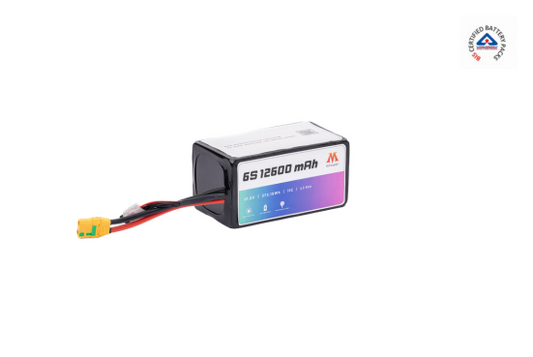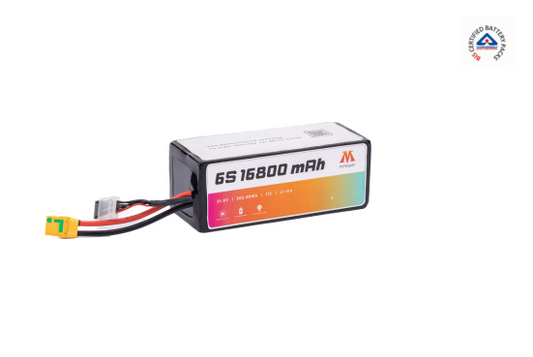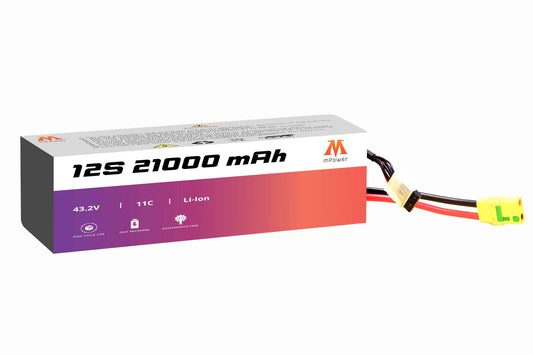Spray drones are one of the fastest-moving agricultural technologies that have impacted the lives of Indian farmers. These unmanned aerial vehicles have revolutionized traditional farming practices by enabling precise spraying of pesticides, fertilizers, and other essential liquids onto crops.
However, a crucial aspect often arises when discussing these drones is their flight duration on a Li ion drone battery charge.
“How long can a spray drone truly stay airborne before requiring a recharge?”
To shed light on this matter, let's delve into the world of sprayer drones and explore the factors influencing their flight time.
The Dawn of Sprayer Drones
Agricultural drones, also called sprayer drones or crop-spraying drones, gained attention for their ability to revolutionize farming practices in the past few years. These advanced machines come equipped with tanks designed to hold liquids like pesticides or fertilizers. From above, they carefully and precisely spray these substances onto crops. This targeted approach reduces wastage and minimizes human exposure to potentially harmful chemicals. Furthermore, it ensures that crops receive optimal coverage in the most efficient manner possible.
Factors Influencing Flight Time
Several factors can impact the flight time of a sprayer drone on a single battery charge. Let's understand these variables more closely:
- Battery Capacity
The battery capacity is the most crucial factor that impacts a drone's flight time. A best drone battery can store more energy, enabling the drone to remain in the air for an extended duration. Innovations in battery technology, such as the evolution of the lithium-ion batteries, have greatly enhanced the energy density and lifespan of drone batteries.
- Drone Weight
The weight of a drone, including its payload, such as liquid tanks and spraying equipment, is directly related to its energy consumption. Heavier drones need more power to generate the required lift and maintain stable flight, resulting in shorter flight times.
- Motor Efficiency
The flight duration of a drone greatly depends on the efficiency of its motors and propulsion system. Modern drones are equipped with brushless motors that offer improved energy efficiency and higher thrust-to-weight ratios to increase flight time. These features enable longer periods of flight.
- Flight Speed and Altitude
To maximize flight time, it's more energy-efficient for drones to fly at slower speeds and lower altitudes. Flying at higher speeds or altitudes consumes more battery power.
- Environmental Conditions
External factors such as wind speed, temperature and humidity can impact the flight time of a drone. When facing strong winds, the drone requires more power to maintain stability, shortening its overall flight duration. Moreover, extreme temperatures can affect battery performance and potentially lead to shorter flights when faced with adverse conditions.
- Flight Path and Navigation
Flight time for sprayer drones is influenced by the flight path and navigation strategy. By implementing efficient flight planning that reduces unnecessary movements and optimizes routes, it is possible to extend the duration of flights.
- Battery Management Systems
The battery life of modern drones is extended and optimized through advanced battery management systems. These systems carefully monitor and control the battery's health and usage to prevent over-discharging, ensure safe operation, and increase flight times.
Realistic Flight Time Expectations
Based on the earlier factors, flight times for sprayer drones can vary significantly. On average, a mid-sized agricultural drone with a payload of around 10-15 liters and the best agricultural spraying batteries can typically fly for approximately 12-16 minutes on a single charge.
It's worth noting that while manufacturers may promote impressive flight durations, real-world conditions often result in variability. The actual flight time you encounter might be shorter, particularly when factoring in variables such as wind, payload weight, and operational procedures.
Mitigating Short Flight Times
- Swappable Batteries
Maintaining multiple batteries enables uninterrupted operation. When one battery runs out, it can be immediately swapped with a charged one, minimizing potential downtime.
- Efficient Flight Planning
Using advanced flight planning software, airlines can optimize routes, minimize unnecessary movements, and save energy. This ultimately leads to longer flight durations.
- Lightweight Design
Opting for lightweight drone designs without compromising structural integrity can contribute to longer flight times.
- Battery Technology Advancements
With advances in battery technology, we can anticipate enhancements in energy capacity, longevity, and overall functionality. These developments hold the potential for substantial increases in flight duration for sprayer drones.
Wrapping Up
Sprayer drones have revolutionized agriculture by enabling more efficient and precise practices. A sprayer drone's flight duration depends on various factors, but recent advances in battery technology, motor efficiency, and overall drone design have significantly improved this aspect. However, another crucial feature to enhance the drone's flight duration is choosing a reliable and genuine battery manufacturer.
mPower is a well-established company that has gained a strong reputation over the years. With our extensive experience and large customer base, we offer the best drone battery specially for agricultural practices. Regarding lithium-ion batteries, mPower stands out as the top choice. Our batteries are renowned for their long lifespan, consistent performance, and extended flight times.












